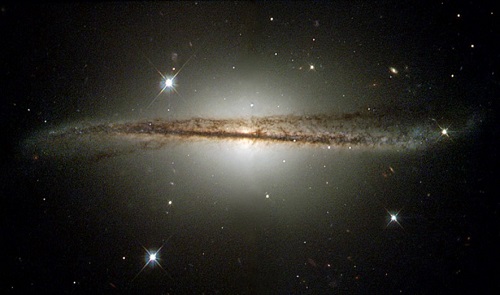
Most spiral galaxies, like Milky Way, have a warped disk, which is like a potato chip in the outer disk. But the origin of warp is still a mystery for astrophysicists.

ESO510-13 warped spiral galaxy, it bends upward and downward in the northern and southern sides (Image by STScl/NASA)
Recently, a research team led by Dr. WANG Haifeng from the National Astronomical Observatories of the Chinese Academy of Sciences (NAOC), collaborating with Dr. Martín López-Corredoira from Instituto de Astrofísica de Canarias in Spain, promoted the understanding of the puzzle that how the warped disk of our home galaxy was from. The study was published in The Astrophysical Journal on July 10.
Like many spiral galaxies in the universe, Milky Way's warp was detected by gas and dust many years ago. Many mechanisms have been proposed but observational evidences may favour some of them. The kinematical information like vertical motions can be used to constrain the warp's properties.
Researchers analyzed the amplitude evolution of the stellar warp independently of any assumption with a simple model by combining LAMOST DR4 and Gaia DR2 common red clump stars with age and proper motion.
"We discovered that the younger stellar populations exhibit stronger warp features than the old ones clearly," said Dr. Martín López-Corredoira.
"All of this self-consistent evidence supports that our galactic warp is most likely a long lived but non-steady structure and not a transient one. This proves that the galactic warp is induced by the non-gravitational interaction over the disk models, e.g., gas falling onto the disk scenario," said Dr. WANG.
"This is the first time here the warp evolution is followed with complete age sampling of the Milky Way thanks to the LAMOST data," said Dr. Martín López-Corredoira.
Referee of this paper pointed out, "this paper presents a new step towards our knowledge of the warp in the Milky Way disk, and its origin."
This group is still fighting for the ambitious plan "Mapping the Milky Way Disk Population Structures and Galactoseismology (MWDPSG)" with large sky surveys.
"We expect that we could establish a theoretical framework in the future to unify the global picture of the disk structures and origins. There is still a long way for us to go with this project and the warp, the topic of this paper is an important part of this plan," said Dr. WANG.

86-10-68597521 (day)
86-10-68597289 (night)

52 Sanlihe Rd., Xicheng District,
Beijing, China (100864)

